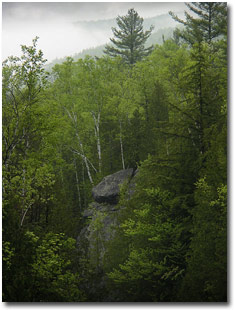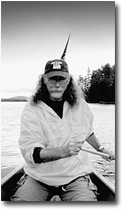Flapdoodle and Green Paint, or, Learn, Baby, LearnText and Photography Copyright Mark Hobson. All rights reserved.
Brooks Jensen states in Things Iíve Learned About Photography, LensWork, #50, "Your success (as a photographer) depends as much upon the viewer as it does on yourself. For purposes of discussion, letís assume that "success" in photography is measured by photographersí ability to communicate with the viewers of their work. On that basis, I think that few would disagree with Jensenís proposition. However, I am equally certain that there would definitely be differing opinions about the responsibilities of the two parties involved.

A face in the forest. Is it real or just an act of the imagination? Full Size Image
|
|
Some might argue that it is the responsibility of photographers to simplify and make obvious the message of their work in order that anyone with a kindergarten-level visual education can understand it at first glance. Others might insist that viewers will get out of their photography exactly what they put into it - the more effort they put into understanding the medium and the message the better they will "see" and the more they will "hear" and understand.
I guess it all comes down to which side of the fence you happen to be on, which brings to mind an interesting and instructive anecdote about an early childhood neighbor of mine - for anonymity sake, letís call him Mr. Dockweller.
Mr. Dockweller (all the adults were Mr/Mrs/Miss when I was a kid except, of course, for the Sisters and Fathers) was a civil engineer for NYS-DOT by trade, a husband and father of 7 (the sound of babies booming), a Boy Scout leader, and a handyman extraordinaire. The voluminous handyman activities were necessitated by the fact that the Dockweller family lived in a small green house that started out with only two bedrooms, an eat-in kitchen, a living room and, most inconveniently, one bathroom. Ah, the joys and perils of being Catholic and emerging middle-class in Grandpa Ikeís 1950s.
But kid life was mostly good and filled with mystery and wonder, and one of lifeís most fascinating neighborhood curiosities for us was Mr. Dockwellerís garage. The Dockweller garage (detatched) was a garage in name only. It may have housed lots of miscellaneous and scattered car parts amongst all the piles and stacks of the detritus of ongoing and never-ending home improvement and repair projects (one of which was to add on to the garage so it could hold more stuff), but a car had never graced its enclosed space.
Nor had any of us kids, including Mr. Dockwellerís own. Nothing sinister here, just sort of an early-era OSHA safety-first kind of thing. He, and he alone, was the sole proprietor and custodian of what we knew had to be a veritable treasure-trove of clubhouse-useable and kids-play junk - remember that this was the 50s and only a few of our "toys" came from a store. If you werenít creative, you were bored. Many a time when we were searching for that perfect accoutrement to our childhood adventures, our lust for a visit to the convoluted passage ways of Mr. Dockweller's menagerie reached a fevered but unrequited pitch.
So, you might be thinking, what does this have to do with Brooks Jensenís statement, photography, or me? Well, believe it or not, this little story leads to a parable about visual discernment/interpretation.
Knowing what I know now, I realize that Mr. Dockweller was balancing a life of responsibilities, commitments and activities that would leave even the most modern of soccer moms (or dads) spinning like a top. How he did it, Iíll never know. Although, with hindsight, I recognize that he did know how to keep all the wheels turning with the help of a little "lubricant" now and again, and on rare occasions, Mr. Dockweller would have what the neighbors quietly referred to as an "episode."
Apparently, in an attempt to attain an "altered state of consciousness" with which to view his world, Mr. Dockweller would lubricate his own particular cog just a bit too much. The result would inevitably be a "trip," as it were, to his outer sanctum (the garage) where he would ruminate and grapple with his inner self. The event was always marked by a steady cacophony of banging, crashing, clattering, murmuring, muttering and the occasional punctuation of a few well chosen, but not particularly well articulated expletives. The proceeding was never overtly violent or offensive, it was just a kind of leisurely-paced, low-grade release of a little of lifeís excess steam.
In a remarkable display of staying power, Mr. Dockweller could keep this whole thing going for the better part of a warm summer afternoon. During this time some of the other neighborhood kids (including the apple of my childhood eye, Ginger Dockweller) would drift over to my backyard (we lived next door) and pretend to do something with a season-appropriate ball while we actually eavesdropped on what came to be known to us as a mysterious ritual. Mysterious, because, when the long-suffering and uncommonly patient Mrs. Dockweller would eventually decide that enough was enough and drag (figuratively) a wide-eyed, arms-a-flapping Mr. Dockweller out of the garage and his revelry, he would make it very clear to one and all within earshot that she had interfered with his discovery of the very meaning of Life, Truth, Beauty and the American Way. He was certain that during these garage based sweat-lodge "episodes", he had, in fact, seen no less than God. Life, its Meaning, and his God where all in there for all to see. You just had to really look.
Now, having heard this, and try as we might, every time we were able to peer into the garage all we were ever able to see (in our kid state of consciousness) was just plain junk - flapdoodle and green paint (the color of the Dockweller house and garage). Although once, when some warm late-day sunlight slanted through a window (and the boards stacked against it) and illuminated the air in the garage with random shafts of light, I thought I saw Daffy Duck flapping around in there, but alas, it was never conclusively confirmed. When queried about the discrepancy between our vision and Mr. Dockwellerís, most neighborhood adults either "didnít want to talk about it", or answered with the standard adult-kid blow-off, "you wouldnít understand."
And guess what? They were right. Not only wouldnít we understand, we couldnít possibly understand - we simply didnít know enough to understand. Itís taken me the better part of a lifetime of experience and learning to understand and appreciate what was going on in that garage. And now I know (or at least have a good idea about it) because I wanted to know. Curiosity may have killed the cat, but, thank God, Iím not a cat, because the desire to know and find out has taken me down many an interesting and challenging road that I would have never followed without it. Iíll admit that I have a few bruises, but nothing life-threatening.
As for Mr. Dockwellerís altered-state-of-consciousness, isnít admitting to yourself that thereís much to learn that you donít already know an altered state of consciousness? The next time you encounter a photograph that challenges your understanding, spend some time with it, forget what you already know, and really look. To paraphrase Henri Cartier-Bresson, "People donít look enough. They think. Itís not the same thing", or, as Albert Einstein said, "Imagination is more important than knowledge."
When asked, "How can I improve my photography/take better pictures?", my advice is always the same - look, really look, at as much of the photography of others as you can, especially that which challenges your expectations and confounds your conventions. Discover/learn how to see through their eyes. Try to hear what they are saying, not just see what they are showing. Strive for empathy.
You may never come to savoir all the photography that you see, but you will learn from it. And, just like the rest of life, you will get out of it in direct proportion to what you put into it. Always remember, just like Mr. Dockwellerís garage with its flapdoodle and green paint, with an open and inquiring mind, things are not always as they seem to be.
PostScript - In this article I have taken a few creative liberties with my childhood experiences and memories, but the gist of it all is quite accurate. Credit for inspiration must also be given to an article read long ago (30 years ago?) entitiled A Helicopter is Not a Milk Cow and Thatís a Fact - at least that Ďs what I remember it as. Unfortunately, my memory can no longer serve up the name of the publication which, I believe, has long since ceased to be.
Mark Hobsonís Photo Workshops feature the Digital Darkroom. For more info click here.
Comments on NPN creative photography articles? Send them to the editor.
MH-NPN 1196
 MARK HOBSON is a family guy lucky enough to be living in his favorite place on earth, the Adirondacks. A former agency creative director and commercial photographer, Mark has brought his love of the wilderness and photography together to form Nessmuk & Stoddard Trekking.
MARK HOBSON is a family guy lucky enough to be living in his favorite place on earth, the Adirondacks. A former agency creative director and commercial photographer, Mark has brought his love of the wilderness and photography together to form Nessmuk & Stoddard Trekking.
Mark's photography has been used by Fortune 500s such as Kodak, Xerox, Heinz, PPG, and Bausch & Lomb. As a creative director he has produced campaigns for clients such as; I LOVE NY, Lake Placid, The Adirondacks, Cooperstown and the Finger Lakes.
His Adirondack photography has been exhibited in galleries in the NE. He has won recognition as a repeat finalist in the Carnegie International Nature Photo Competition. Mark has also been a judge for the Kodak International Snapshot Competition as well as the Kodak Camera Club.
Mark offers comprehensive written portfolio reviews for amateur and professional photographers. Contact him at photoworkshop@charter.net for details.
Be sure to visit Mark's website at www.adirondacklight.net.
Comments on NPN creative nature photography articles? Send them to the editor.


| 


